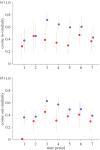Network integration and limits to social inheritance in vervet monkeys
- PMID: 29643208
- PMCID: PMC5904308
- DOI: 10.1098/rspb.2017.2668
Network integration and limits to social inheritance in vervet monkeys
Abstract
Social networks can be adaptive for members and a recent model (Ilany and Akçay 2016 Nat. Comm.7, 12084 (doi:10.1038/ncomms12084)) has demonstrated that network structure can be maintained by a simple process of social inheritance. Here, we ask how juvenile vervet monkeys integrate into their adult grooming networks, using the model to test whether observed grooming patterns replicate network structure. Female juveniles, who are philopatric, increased their grooming effort towards adults more than males, although this was not reciprocated by the adults themselves. While more consistent maternal grooming networks, together with maternal network strength, predicted increasing similarity in the patterning of mother-daughter grooming allocations, daughters' grooming networks generally did not match closely those of their mothers. However, maternal networks themselves were not very consistent across time, thus presenting youngsters with a moving target that may be difficult to match. Observed patterns of juvenile female grooming did not replicate the adult network, for which increased association with adults not groomed by their mothers would be necessary. These results suggest that network flexibility, not stability, characterizes our groups and that juveniles are exposed to, and must learn to cope with, temporal shifts in network structure. We hypothesize that this may lead to individual variation in behavioural flexibility, which in turn may help explain why and how variation in sociability influences fitness.
Keywords: behavioural flexibility; grooming; social development; social integration; vervet monkeys.
© 2018 The Author(s).
Conflict of interest statement
We have no competing interests.
Figures



Similar articles
-
The consistency of individual centrality across time and networks in wild vervet monkeys.Am J Primatol. 2021 Feb;83(2):e23232. doi: 10.1002/ajp.23232. Epub 2021 Jan 19. Am J Primatol. 2021. PMID: 33464611
-
The effects of data collection and observation methods on uncertainty of social networks in wild primates.Am J Primatol. 2020 Jul;82(7):e23137. doi: 10.1002/ajp.23137. Epub 2020 Apr 20. Am J Primatol. 2020. PMID: 32310316
-
Supply and demand determine the market value of food providers in wild vervet monkeys.Proc Natl Acad Sci U S A. 2009 Jul 21;106(29):12007-12. doi: 10.1073/pnas.0812280106. Epub 2009 Jul 6. Proc Natl Acad Sci U S A. 2009. PMID: 19581578 Free PMC article.
-
Primates are living links to our past: The contribution of comparative studies with wild vervet monkeys to the field of social cognition.Cortex. 2019 Sep;118:65-81. doi: 10.1016/j.cortex.2019.03.007. Epub 2019 Mar 21. Cortex. 2019. PMID: 30987738 Review.
-
Sociability as a personality trait in animals: methods, causes and consequences.Biol Rev Camb Philos Soc. 2022 Apr;97(2):802-816. doi: 10.1111/brv.12823. Epub 2021 Dec 10. Biol Rev Camb Philos Soc. 2022. PMID: 34894041 Review.
Cited by
-
Social network inheritance and differentiation in wild baboons.R Soc Open Sci. 2023 May 24;10(5):230219. doi: 10.1098/rsos.230219. eCollection 2023 May. R Soc Open Sci. 2023. PMID: 37234491 Free PMC article.
-
Demographic turnover can be a leading driver of hierarchy dynamics, and social inheritance modifies its effects.Philos Trans R Soc Lond B Biol Sci. 2023 Aug 14;378(1883):20220308. doi: 10.1098/rstb.2022.0308. Epub 2023 Jun 26. Philos Trans R Soc Lond B Biol Sci. 2023. PMID: 37381857 Free PMC article.
-
Social induction and the developmental trajectory of participation in intergroup conflict by vervet monkeys.Evol Hum Sci. 2025 Mar 13;7:e9. doi: 10.1017/ehs.2025.7. eCollection 2025. Evol Hum Sci. 2025. PMID: 40162067 Free PMC article.
-
The coevolution of cognition and sociality.Philos Trans R Soc Lond B Biol Sci. 2025 Jun 26;380(1929):20240110. doi: 10.1098/rstb.2024.0110. Epub 2025 Jun 26. Philos Trans R Soc Lond B Biol Sci. 2025. PMID: 40566915 Free PMC article. Review.
-
Urbanization does not increase "object curiosity" in vervet monkeys, but semi-urban individuals selectively explore food-related anthropogenic items.Curr Zool. 2024 May 3;70(3):383-393. doi: 10.1093/cz/zoae022. eCollection 2024 Jun. Curr Zool. 2024. PMID: 39035753 Free PMC article.
References
-
- Young C, McFarland R, Barrett L, Henzi SP. 2017. Formidable females and the power trajectories of socially integrated male vervet monkeys. Anim. Behav. 125, 61–67. (10.1016/j.anbehav.2017.01.006) - DOI
Publication types
MeSH terms
Associated data
LinkOut - more resources
Full Text Sources
Other Literature Sources

